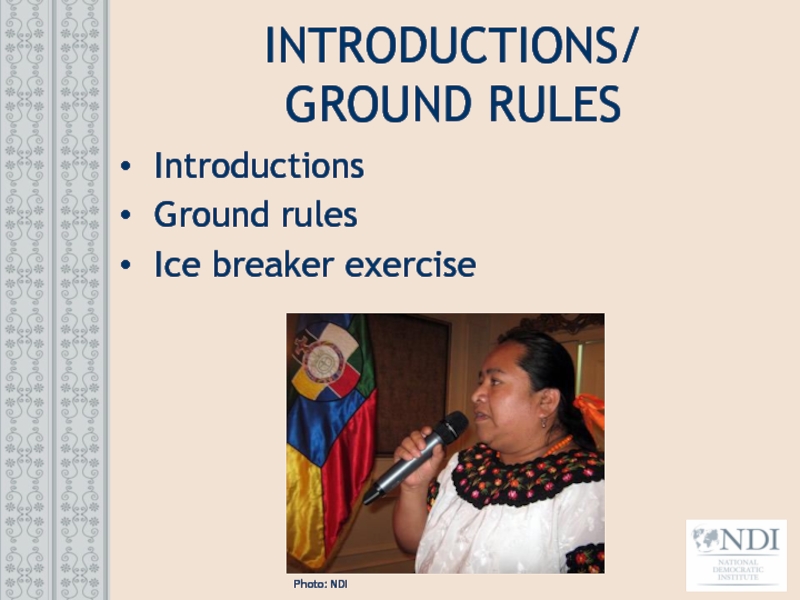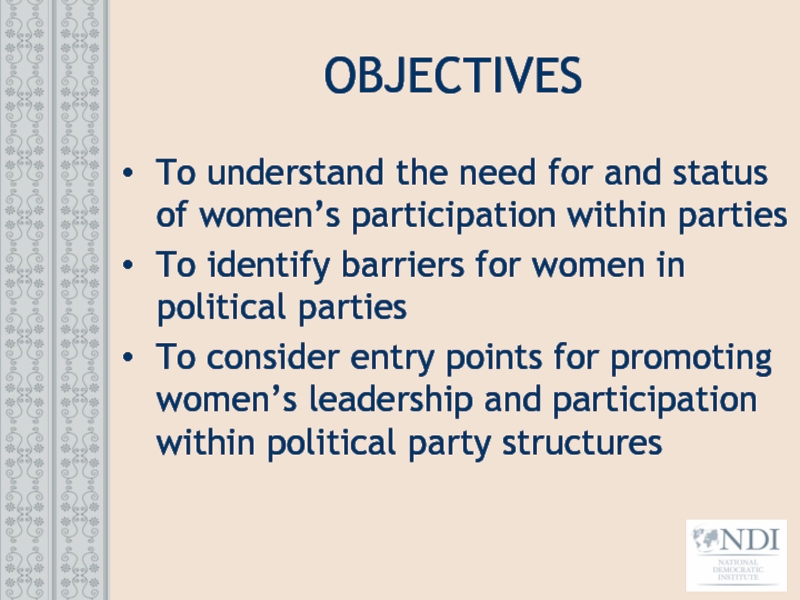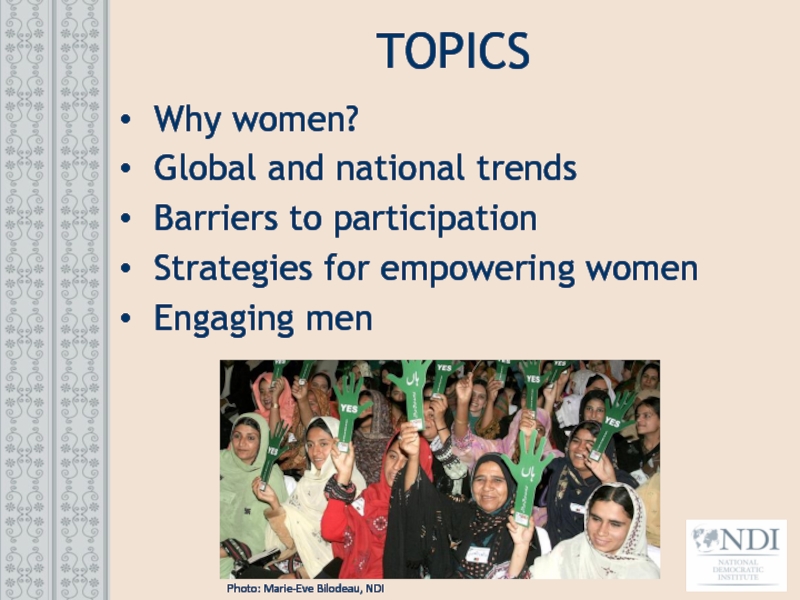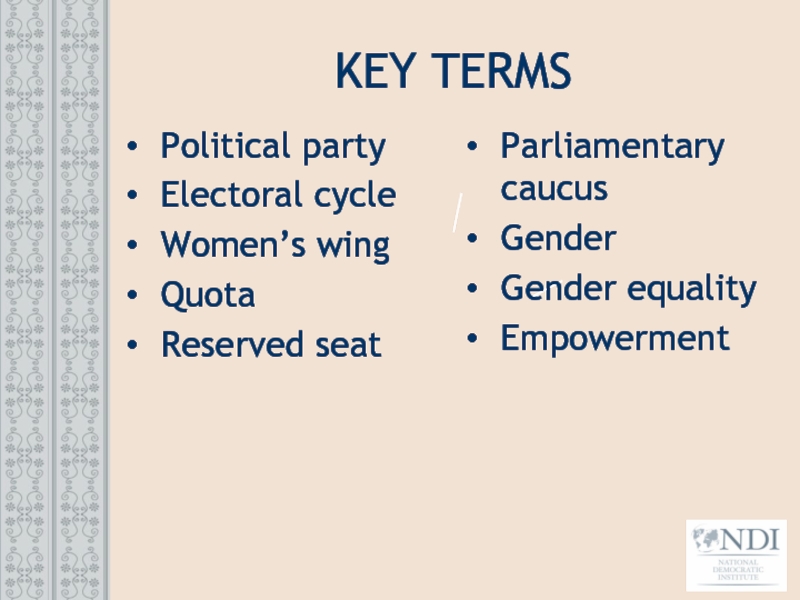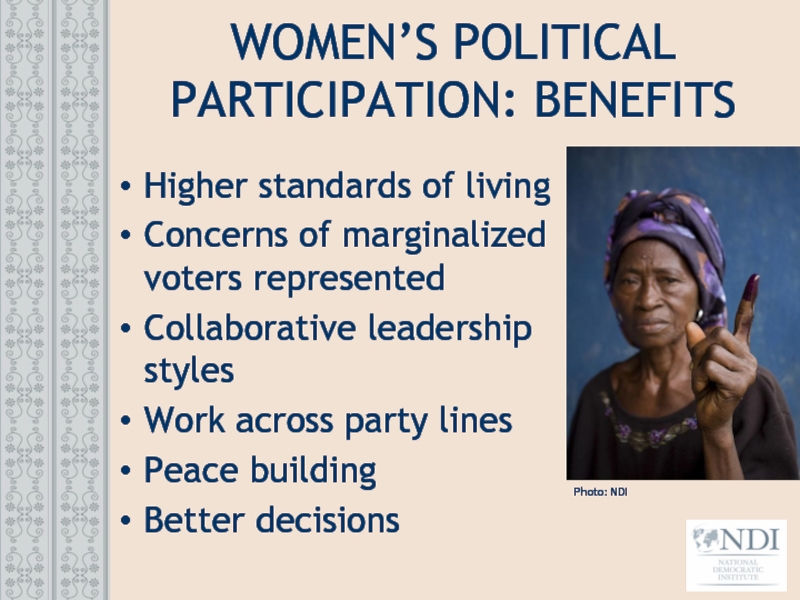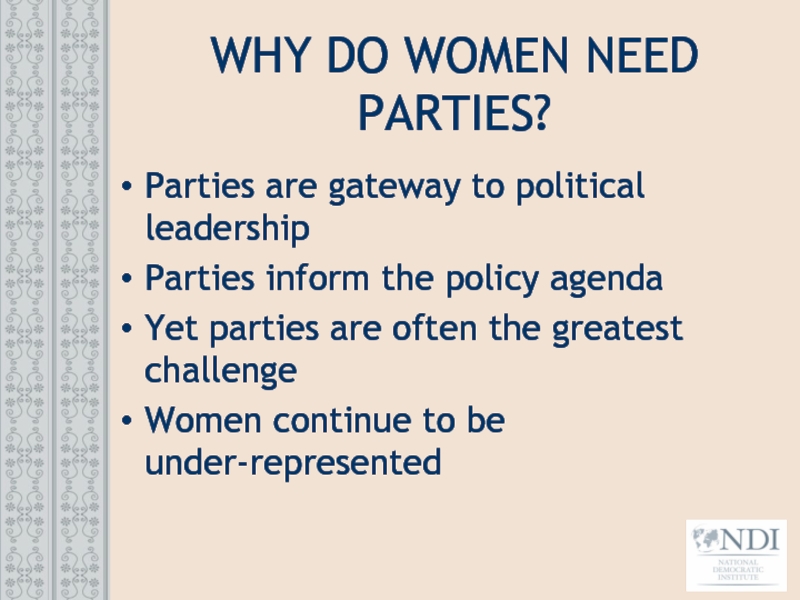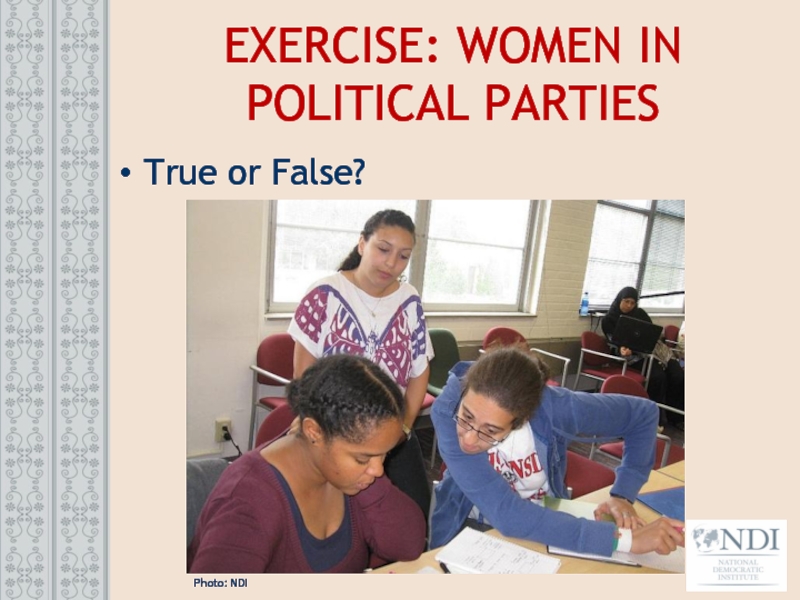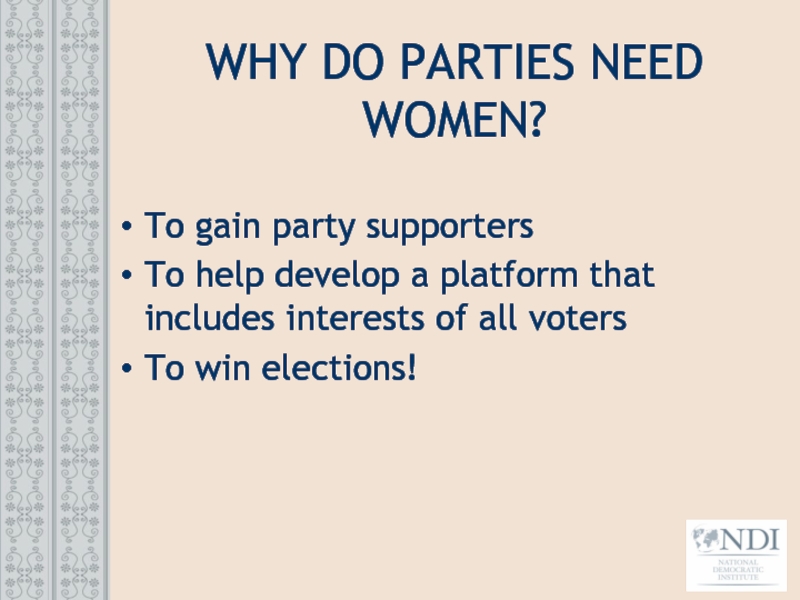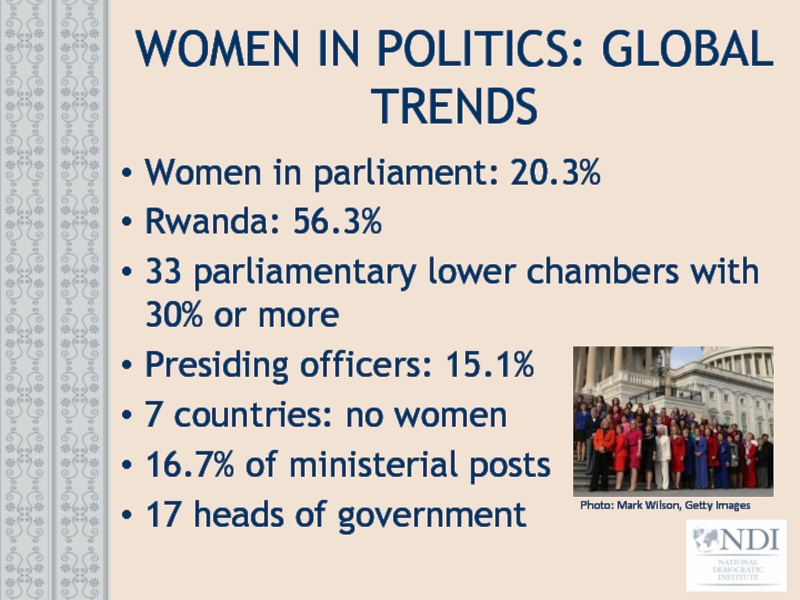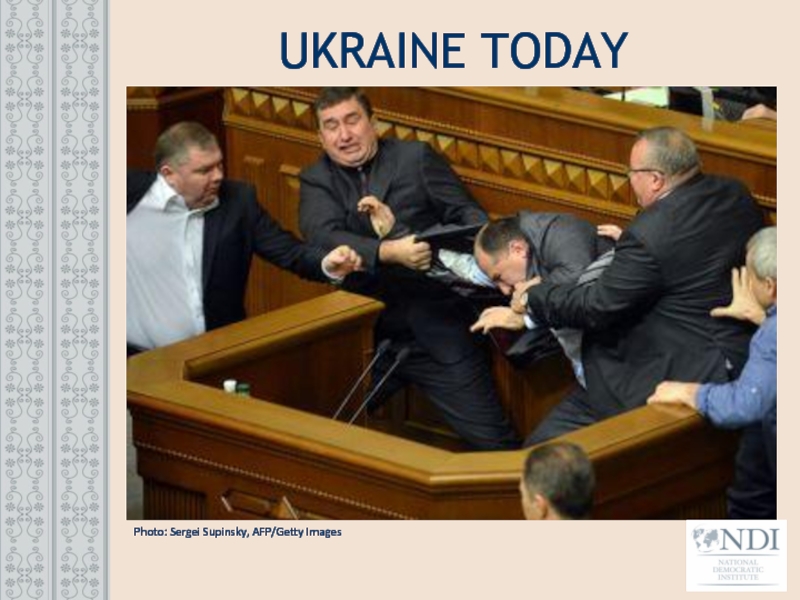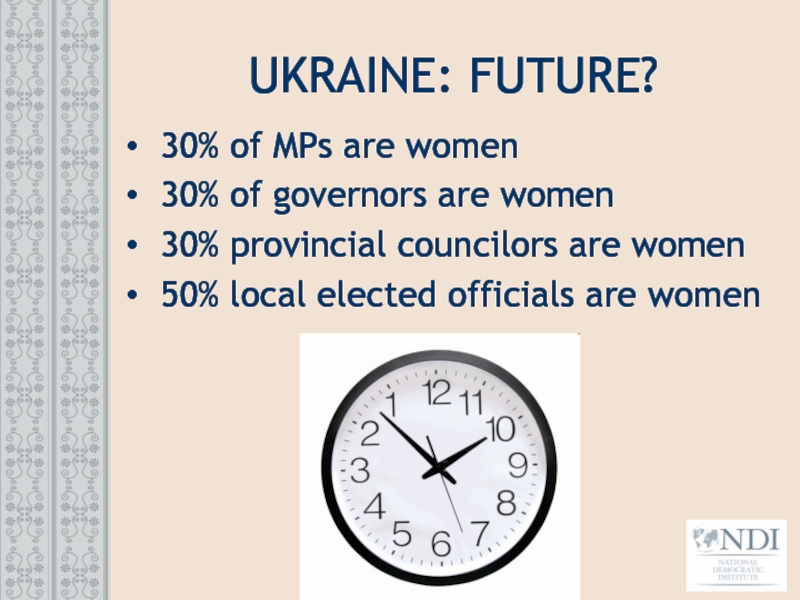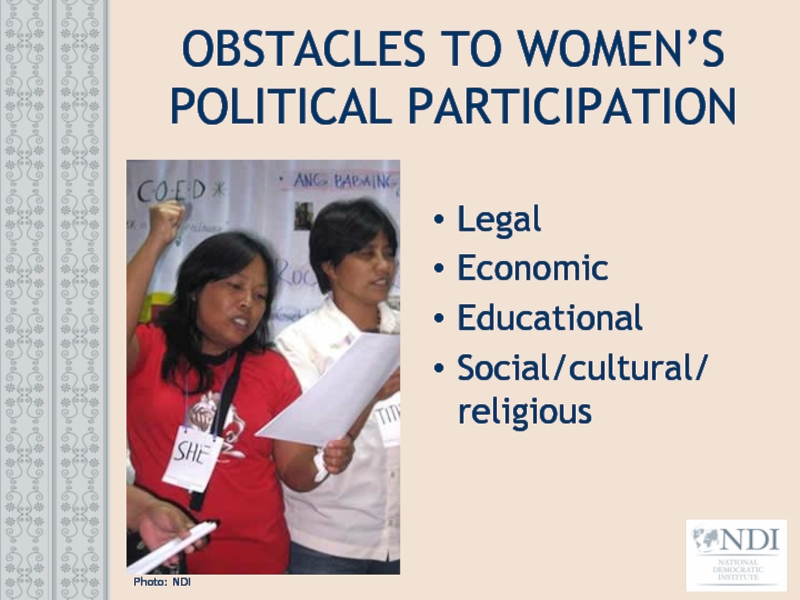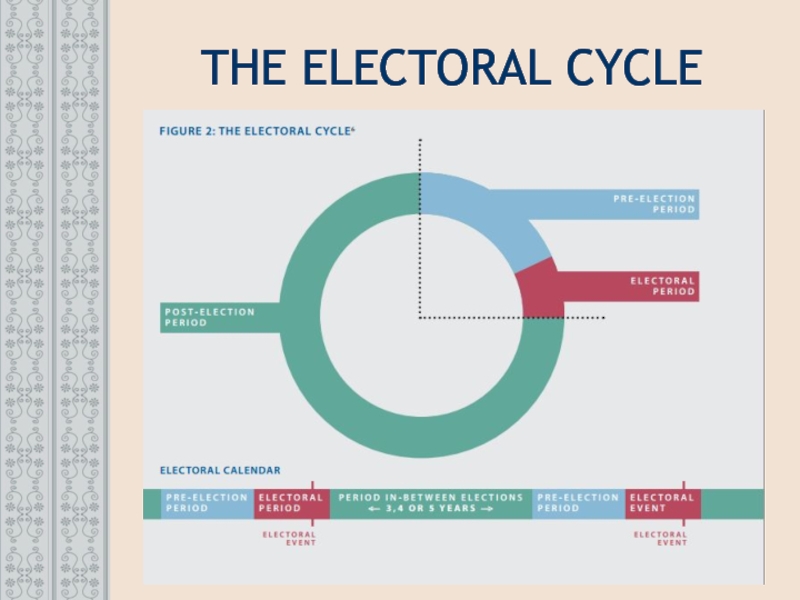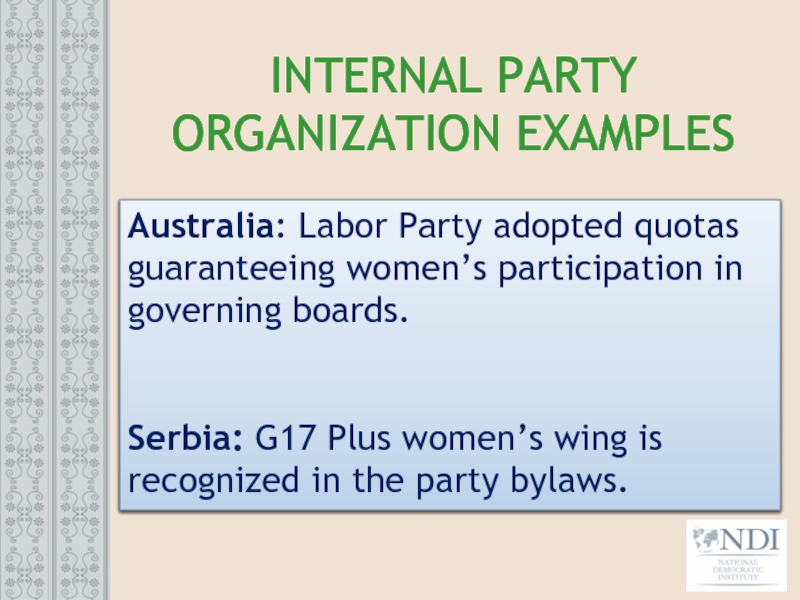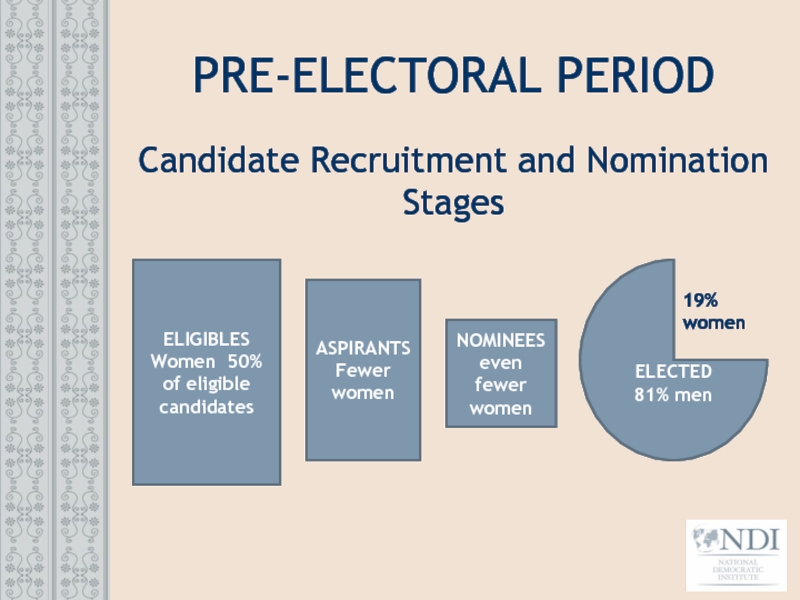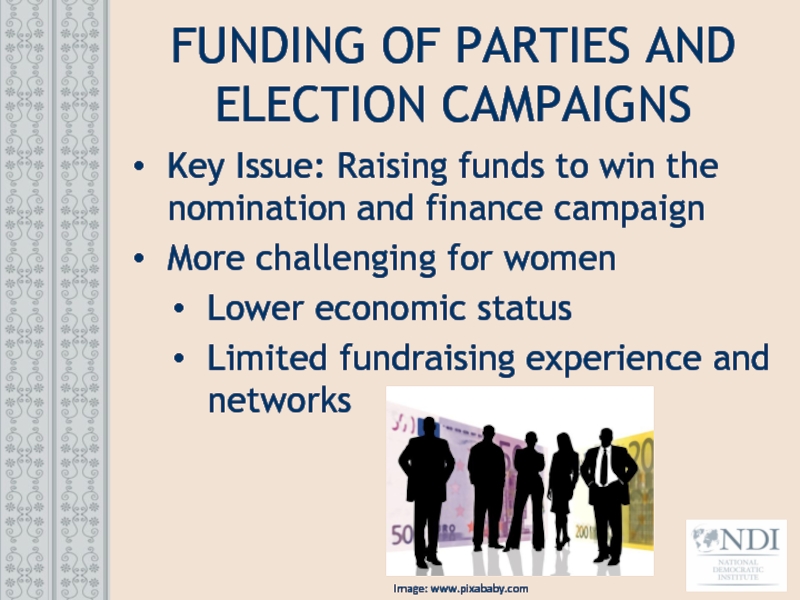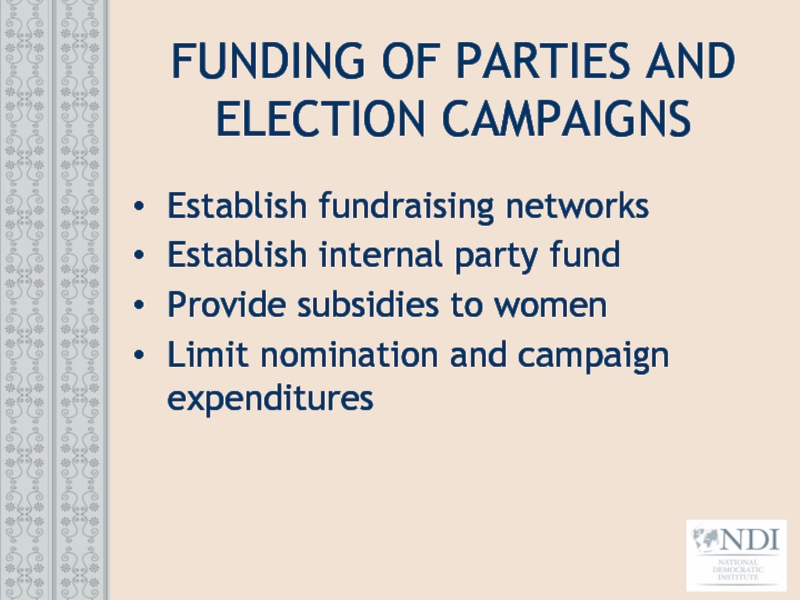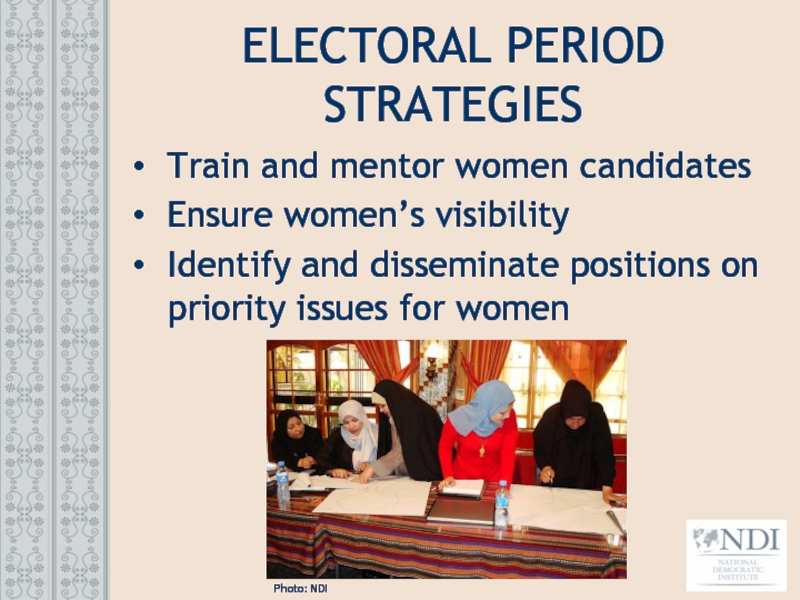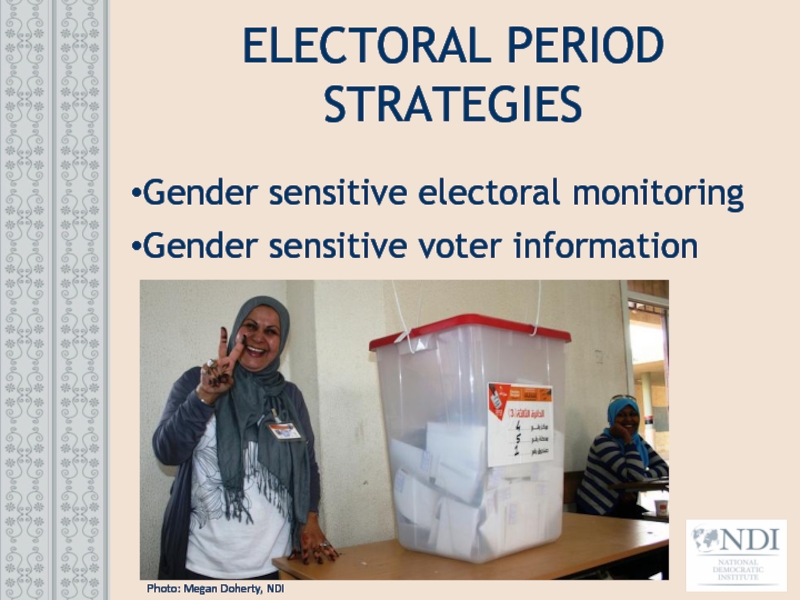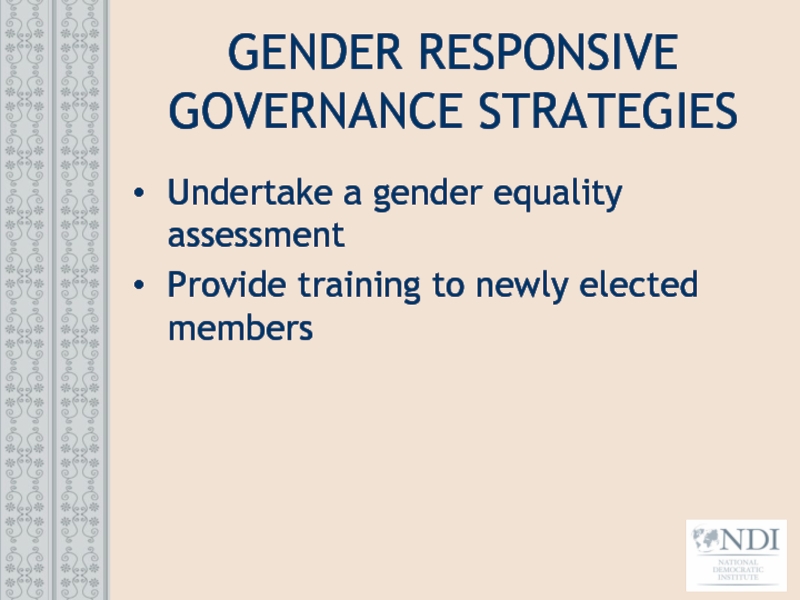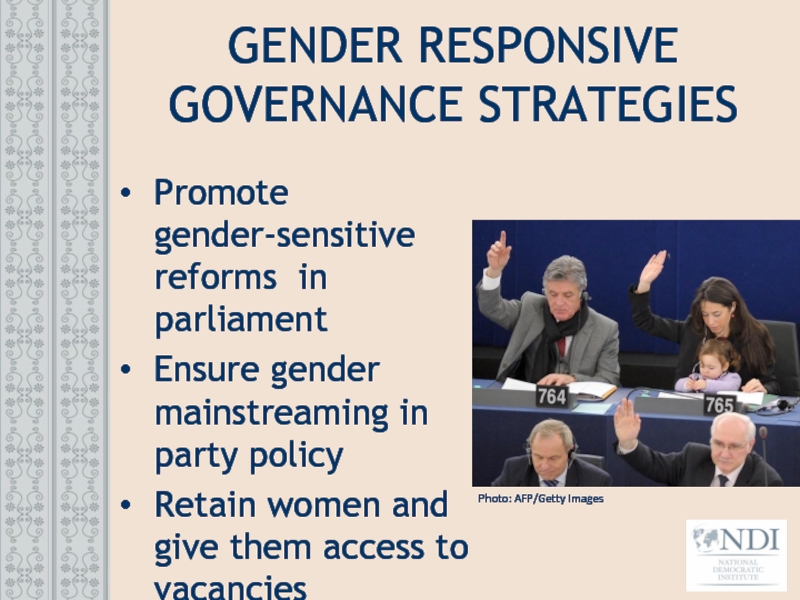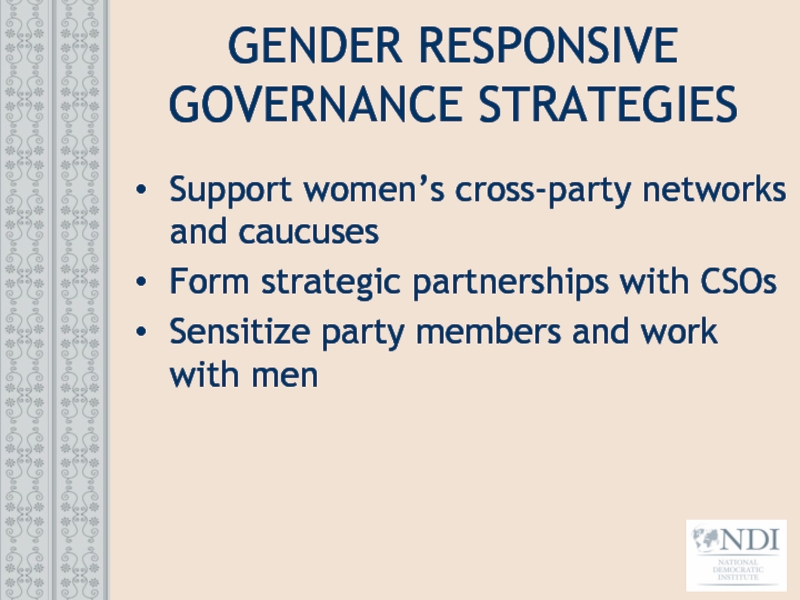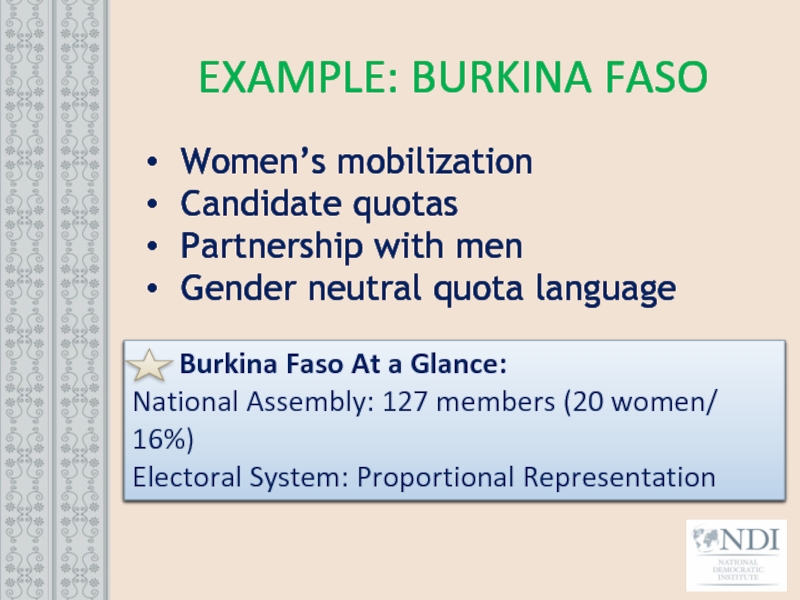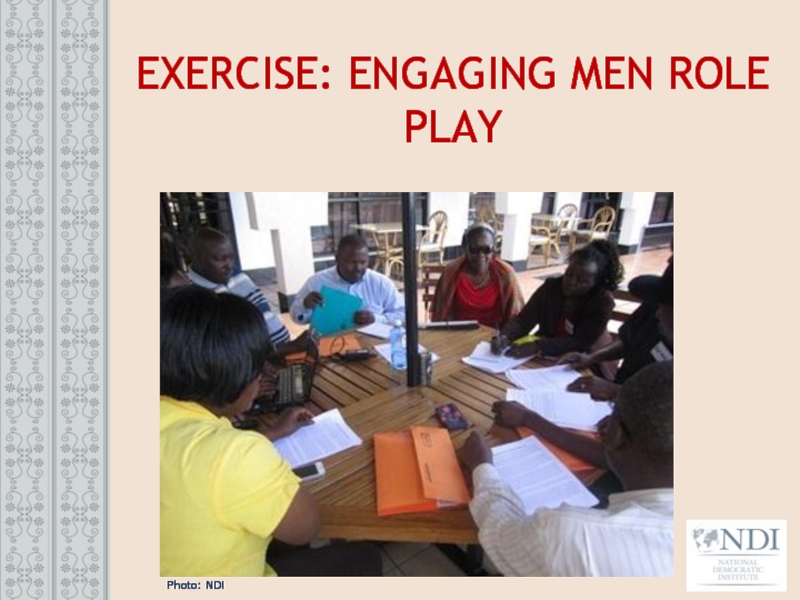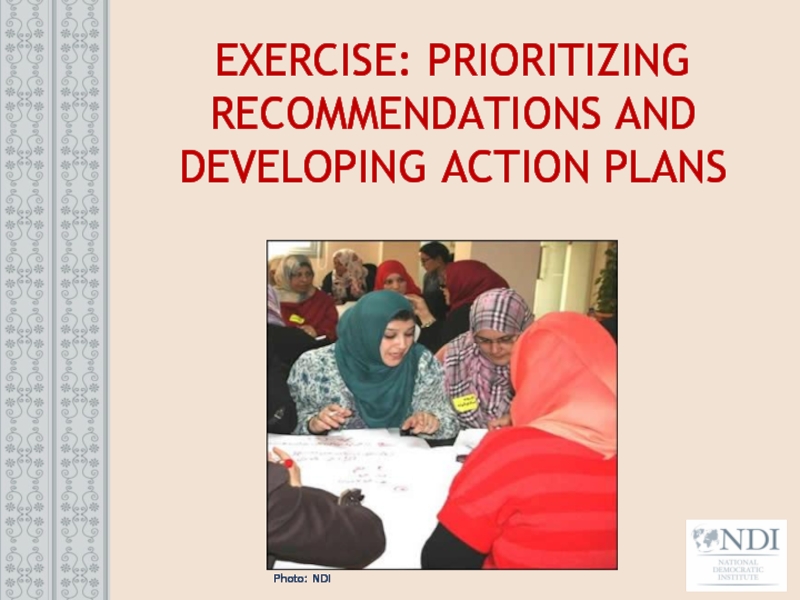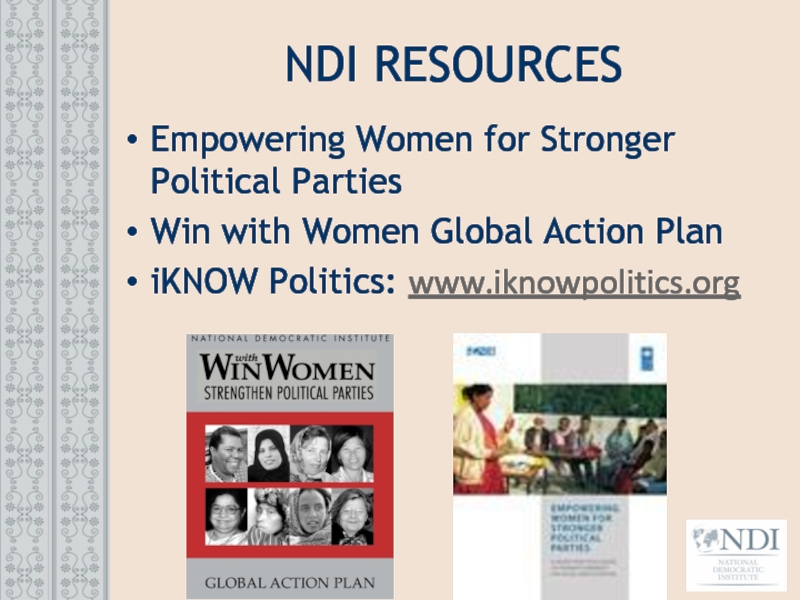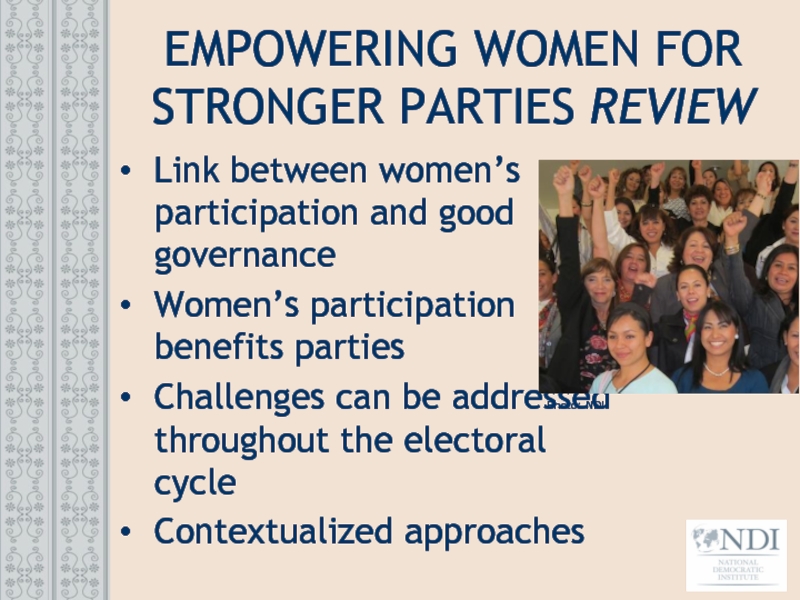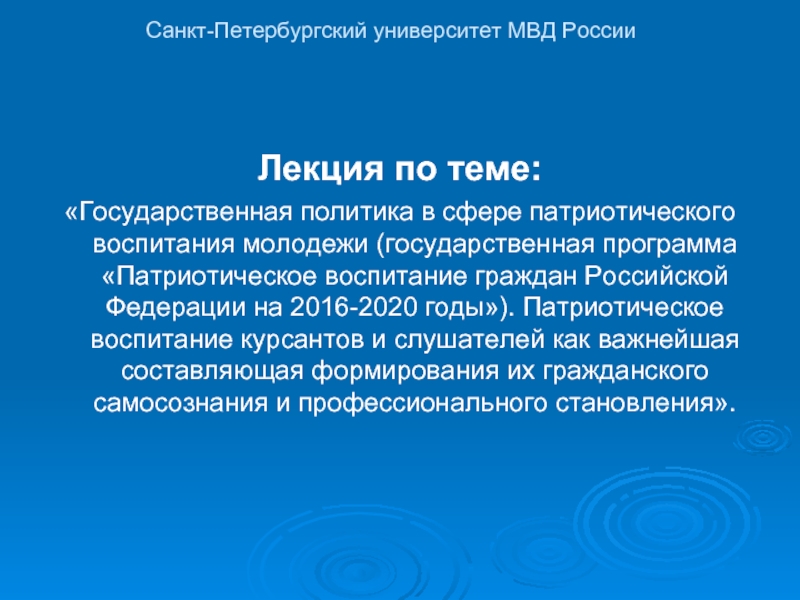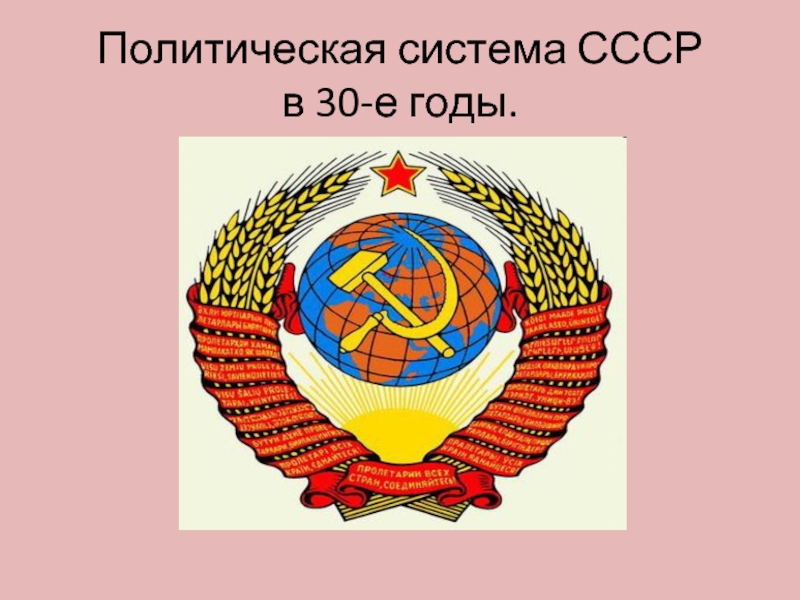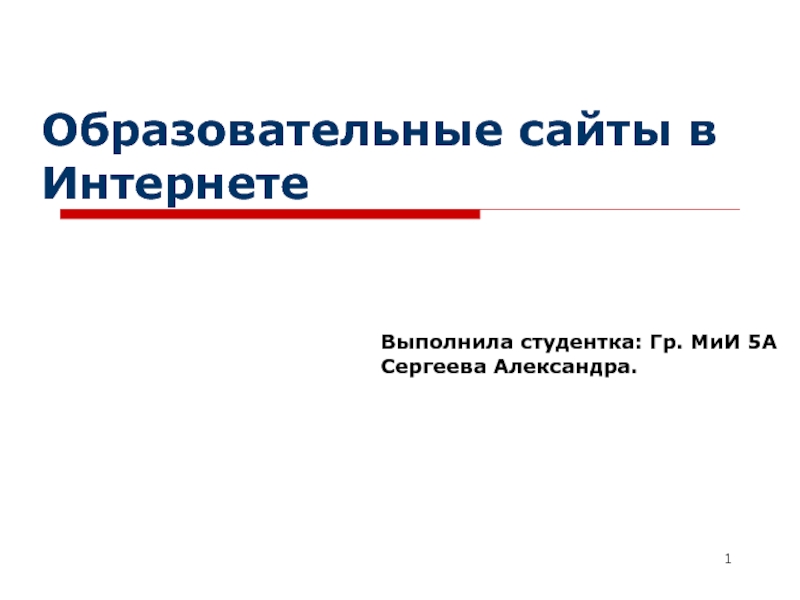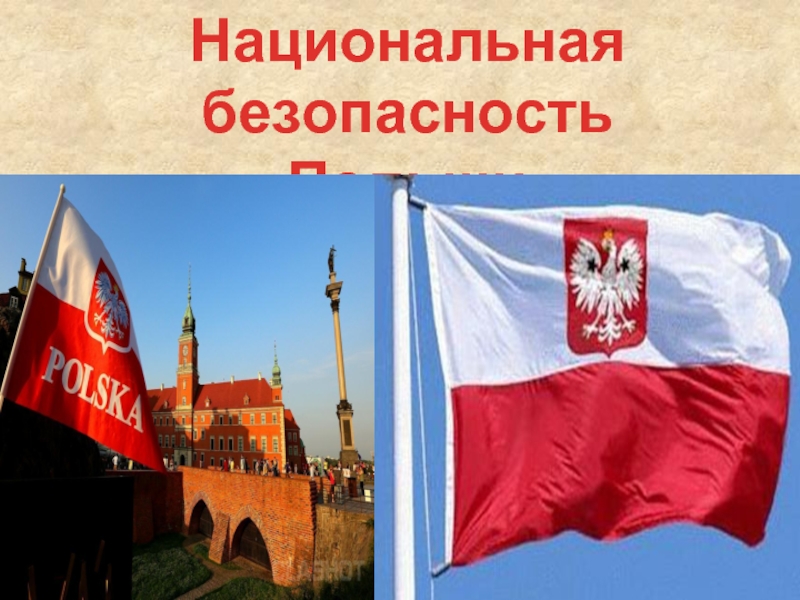- Главная
- Разное
- Дизайн
- Бизнес и предпринимательство
- Аналитика
- Образование
- Развлечения
- Красота и здоровье
- Финансы
- Государство
- Путешествия
- Спорт
- Недвижимость
- Армия
- Графика
- Культурология
- Еда и кулинария
- Лингвистика
- Английский язык
- Астрономия
- Алгебра
- Биология
- География
- Детские презентации
- Информатика
- История
- Литература
- Маркетинг
- Математика
- Медицина
- Менеджмент
- Музыка
- МХК
- Немецкий язык
- ОБЖ
- Обществознание
- Окружающий мир
- Педагогика
- Русский язык
- Технология
- Физика
- Философия
- Химия
- Шаблоны, картинки для презентаций
- Экология
- Экономика
- Юриспруденция
Empowering women for stronger political parties. Women and political parties презентация
Содержание
- 1. Empowering women for stronger political parties. Women and political parties
- 2. Introductions Ground rules Ice breaker exercise INTRODUCTIONS/ GROUND RULES Photo: NDI
- 3. OBJECTIVES To understand the need for and
- 4. TOPICS Why women? Global and national trends
- 5. KEY TERMS Political party Electoral cycle Women’s
- 6. WOMEN’S POLITICAL PARTICIPATION: BENEFITS Higher standards of
- 7. WHY DO WOMEN NEED PARTIES? Parties are
- 8. EXERCISE: WOMEN IN POLITICAL PARTIES True or False? Photo: NDI
- 9. WHY DO PARTIES NEED WOMEN? To gain
- 10. WOMEN IN POLITICS: GLOBAL TRENDS Women in
- 11. UKRAINE COUNTRY DATA 63% of Ukrainian voters
- 12. WOMEN LEADERS
- 13. UKRAINE TODAY Photo: Sergei Supinsky, AFP/Getty Images
- 14. UKRAINE: FUTURE? 30% of MPs are women
- 15. EXERCISE Women’s political participation: identifying helping and hindering forces Image: Inter-parliamentary Union
- 16. OBSTACLES TO WOMEN’S POLITICAL PARTICIPATION Legal Economic Educational Social/cultural/ religious Photo: NDI
- 17. OBSTACLES TO WOMEN’S POLITICAL PARTICIPATION Time Space Physical security Lack of confidence Political parties
- 18. EXERCISE Who does what within the party? Photo: Amy Hamelin, NDI
- 19. THE ELECTORAL CYCLE
- 20. INTERNAL PARTY ORGANIZATION Revise legal framework Ensure
- 21. INTERNAL PARTY ORGANIZATION EXAMPLES Australia: Labor
- 22. PRE-ELECTORAL PERIOD Candidate Recruitment and Nomination Stages
- 23. CANDIDATE RECRUITMENT AND NOMINATION Key Issues Quotas
- 24. CANDIDATE RECRUITMENT AND NOMINATION STRATEGIES Party support
- 25. CANDIDATE RECRUITMENT AND NOMINATION STRATEGIES Work with
- 26. FUNDING OF PARTIES AND ELECTION CAMPAIGNS
- 27. FUNDING OF PARTIES AND ELECTION CAMPAIGNS Establish
- 28. FUNDING OF PARTIES AND ELECTION CAMPAIGNS
- 29. EXAMPLE: EMILY’S LIST American organization Seeks to
- 30. ELECTORAL PERIOD Key Issues Access to funding
- 31. ELECTORAL PERIOD STRATEGIES Train and mentor women
- 32. ELECTORAL PERIOD STRATEGIES Gender sensitive electoral monitoring
- 33. POST-ELECTORAL PERIOD Gender Responsive Governance Formulate
- 34. GENDER RESPONSIVE GOVERNANCE STRATEGIES Undertake a gender equality assessment Provide training to newly elected members
- 35. GENDER RESPONSIVE GOVERNANCE STRATEGIES Promote gender-sensitive reforms
- 36. GENDER RESPONSIVE GOVERNANCE STRATEGIES Support women’s cross-party
- 37. EXERCISE: POLITICAL PARTY ASSESSMENT Photo: NDI
- 38. EXAMPLE: BURKINA FASO Women’s mobilization Candidate quotas
- 39. EXERCISE: ENGAGING MEN ROLE PLAY Photo: NDI
- 40. EXERCISE: PRIORITIZING RECOMMENDATIONS AND DEVELOPING ACTION PLANS Photo: NDI
- 41. PUBLIC OPINION RESEARCH Ukraine (2010) Do you
- 42. NDI RESOURCES Empowering Women for Stronger Political
- 43. EMPOWERING WOMEN FOR STRONGER PARTIES REVIEW Link
Слайд 1EMPOWERING WOMEN FOR STRONGER POLITICAL PARTIES
Women and Political Parties
The National
Слайд 3OBJECTIVES
To understand the need for and status of women’s participation within
To identify barriers for women in political parties
To consider entry points for promoting women’s leadership and participation within political party structures
Слайд 4TOPICS
Why women?
Global and national trends
Barriers to participation
Strategies for empowering women
Engaging men
Photo:
Слайд 5KEY TERMS
Political party
Electoral cycle
Women’s wing
Quota
Reserved seat
Parliamentary caucus
Gender
Gender equality
Empowerment
Слайд 6WOMEN’S POLITICAL PARTICIPATION: BENEFITS
Higher standards of living
Concerns of marginalized voters represented
Collaborative
Work across party lines
Peace building
Better decisions
Photo: NDI
Слайд 7WHY DO WOMEN NEED PARTIES?
Parties are gateway to political leadership
Parties inform
Yet parties are often the greatest challenge
Women continue to be under-represented
Слайд 9WHY DO PARTIES NEED WOMEN?
To gain party supporters
To help develop
To win elections!
Слайд 10WOMEN IN POLITICS: GLOBAL TRENDS
Women in parliament: 20.3%
Rwanda: 56.3%
33 parliamentary lower
Presiding officers: 15.1%
7 countries: no women
16.7% of ministerial posts
17 heads of government
Photo: Mark Wilson, Getty Images
Слайд 11UKRAINE COUNTRY DATA
63% of Ukrainian voters are women
7.5% of MPs are
0% of Ukrainian ministers are women
0% of Ukrainian governors are women
Слайд 14UKRAINE: FUTURE?
30% of MPs are women
30% of governors are women
30% provincial
50% local elected officials are women
Слайд 15EXERCISE
Women’s political participation: identifying helping and hindering forces
Image: Inter-parliamentary Union
Слайд 16OBSTACLES TO WOMEN’S POLITICAL PARTICIPATION
Legal
Economic
Educational
Social/cultural/ religious
Photo: NDI
Слайд 17OBSTACLES TO WOMEN’S POLITICAL PARTICIPATION
Time
Space
Physical security
Lack of confidence
Political parties
Слайд 20INTERNAL PARTY ORGANIZATION
Revise legal framework
Ensure participation in decision-making
Set targets for participation
Establish/strengthen women’s wings
Mainstream gender in policy development
Слайд 21INTERNAL PARTY ORGANIZATION EXAMPLES
Australia: Labor Party adopted quotas guaranteeing women’s participation
Serbia: G17 Plus women’s wing is recognized in the party bylaws.
Слайд 22PRE-ELECTORAL PERIOD
Candidate Recruitment and Nomination Stages
NOMINEES even fewer women
ASPIRANTS Fewer women
ELIGIBLES
Women 50% of eligible candidates
ELECTED
81% men
19%
women
Слайд 23CANDIDATE RECRUITMENT AND NOMINATION
Key Issues
Quotas
Candidate Quotas
Reserved Seats
Placement and Enforcement
Voluntary – adopted by parties
Legislated – legally required
Слайд 24CANDIDATE RECRUITMENT AND NOMINATION STRATEGIES
Party support for quotas
Guidelines for candidate recruitment
Implementation and placement in winnable positions
Photo: Amy Hamelin, NDI
Слайд 25CANDIDATE RECRUITMENT AND NOMINATION STRATEGIES
Work with CSOs to monitor compliance
Cultivate strategic
Expand the pool of viable candidates
Encourage sharing of experiences
Слайд 26FUNDING OF PARTIES AND ELECTION CAMPAIGNS
Key Issue: Raising funds to
More challenging for women
Lower economic status
Limited fundraising experience and networks
Image: www.pixababy.com
Слайд 27FUNDING OF PARTIES AND ELECTION CAMPAIGNS
Establish fundraising networks
Establish internal party fund
Provide
Limit nomination and campaign expenditures
Слайд 28FUNDING OF PARTIES AND ELECTION CAMPAIGNS
Public funding of parties
Funds for
Gender responsive budgeting
Image: www.pixababy.com
Слайд 29EXAMPLE: EMILY’S LIST
American organization
Seeks to elect Democratic women
1985: 25 women raised
2010: 700,000 members raised $82 million
Provides funding and training
Photo: www.emilyslist.org
Слайд 30ELECTORAL PERIOD
Key Issues
Access to funding and media
Capacity building for women
Targeting women
Articulating positions on gender
Слайд 31ELECTORAL PERIOD STRATEGIES
Train and mentor women candidates
Ensure women’s visibility
Identify and disseminate
Photo: NDI
Слайд 32ELECTORAL PERIOD STRATEGIES
Gender sensitive electoral monitoring
Gender sensitive voter information
Photo: Megan Doherty,
Слайд 33POST-ELECTORAL PERIOD
Gender Responsive Governance
Formulate policy
Set governance priorities
Address the concerns of
Photo: NDI
Слайд 34GENDER RESPONSIVE GOVERNANCE STRATEGIES
Undertake a gender equality assessment
Provide training to newly
Слайд 35GENDER RESPONSIVE GOVERNANCE STRATEGIES
Promote gender-sensitive reforms in parliament
Ensure gender mainstreaming in
Retain women and give them access to vacancies
Photo: AFP/Getty Images
Слайд 36GENDER RESPONSIVE GOVERNANCE STRATEGIES
Support women’s cross-party networks and caucuses
Form strategic partnerships
Sensitize party members and work with men
Слайд 38EXAMPLE: BURKINA FASO
Women’s mobilization
Candidate quotas
Partnership with men
Gender neutral quota language
National Assembly: 127 members (20 women/ 16%)
Electoral System: Proportional Representation
Слайд 41PUBLIC OPINION RESEARCH
Ukraine (2010)
Do you think that higher female representation in
47% of respondent said yes
25% said no
Is the gender of a candidate important?
59% do not care
Слайд 42NDI RESOURCES
Empowering Women for Stronger Political Parties
Win with Women Global Action
iKNOW Politics: www.iknowpolitics.org
Слайд 43EMPOWERING WOMEN FOR STRONGER PARTIES REVIEW
Link between women’s participation and good
Women’s participation benefits parties
Challenges can be addressed throughout the electoral cycle
Contextualized approaches
Photo: NDI

